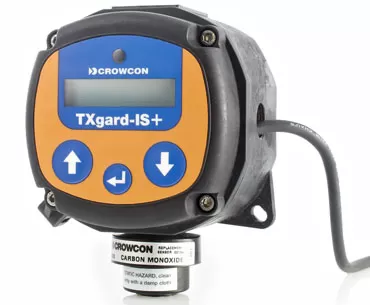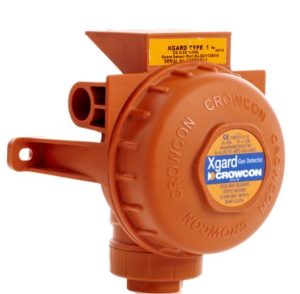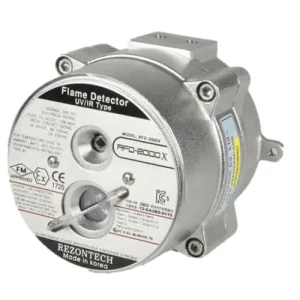The Fire and Gas detection system provides early and reliable detection of fire or gas, where such events are likely to occur, alerts personnel and initiates protective actions automatically or manually upon operator activation.
Fire and Gas System or portion of a combination system that consists of components and circuits arranged to monitor and annunciate the status of fire or presence of gas alarm or supervisory signal-initiating devices and to initiate the appropriate response to those signals.
Gas detection systems provide warning to plant personnel of a release of a combustible gas so that actions, automatic and/or manual, can be taken to control the release before any significant damage can occur. These actions can include process system shutdowns and suppression or mitigation systems actuation.
A FGS that automatically initiates process actions to help prevent or mitigate a hazardous event can be considered a Safety Instrumented Function (SIF) or SIS. … Fire and Gas Systems can mitigate a hazardous event.
Industrial Standards are playing a large role in developing, implementing and installing fire and gas systems. The IEC 61511 standard (ANSI/ISA S84.01 in the U.S.) is a major step towards protecting industrial plants. The overall safety lifecycle model described in the IEC standard lists all of the necessary project activities, from the concept (definition) phase to the decommissioning phase, necessary to ensure the functional safety of equipment under control (EUC). These activities can be divided over a wide range of categories such as procedures, documentation, testing and validation, planning, hardware and software development, and risk assessment. More recently, there have been discussions over whether fire and gas detection systems should contribute to risk reduction or be considered as a protection for the installation only. The implementation of the IEC 61511 and S84.01 standards is becoming increasingly prevalent for F&G detection systems. An ISA technical report TR84.00.07 to provide guidance on the evaluation of fire & gas system effectiveness is currently in draft review. The IEC 61511 standard concerns the determination and development of risk reduction measures (RRMs) required as the outcome of the EUC risk assessment. The basic principle of risk assessment is that all potential risks to the EUC are identified and analyzed. This includes calculating the probability of each potential EUC hazard and determining the risk reduction measures required to achieve an acceptable SIL.
A layered safety strategy unifies all plant protection layers (i.e., basic control, prevention and mitigation as outlined in IEC 61511 standard) required for achieving optimum functional safety. Plus, it provides the required functional safety with a high SIL. This includes superior visualization and logging facilities enabling optimal operator response and accurate evaluations. By integrating basic control, prevention and mitigation components, overall project costs and ongoing maintenance expenses can be vastly reduced.
A truly integrated safety system delivers:
• Integrated operational interface
• Integrated peer control
• Integrated diagnostics
• Integrated postmortem analysis
• Integrated fire and gas system
• Integrated power supplies
• Integrated modifications
• Integrated simulation and optimization
Atrin Radmehr Co. offers a variety of equipment of F&G Panels with the following brands:
Crowcon, HIMAm, Scame,
A flame detector is a sensor designed to detect and respond to the presence of a flame or fire, allowing flame detection. Responses to a detected flame depend on the installation, but can include sounding an alarm, deactivating a fuel line (such as a propane or a natural gas line), and activating a fire suppression system. When used in applications such as industrial furnaces, their role is to provide confirmation that the furnace is working properly; it can be used to turn off the ignition system though in many cases they take no direct action beyond notifying the operator or control system. A flame detector can often respond faster and more accurately than a smoke or heat detector due to the mechanisms it uses to detect the flame

Ultraviolet detector
Ultraviolet (UV) detectors work by detecting the UV radiation emitted at the instant of ignition. While capable of detecting fires and explosions within 3–4 milliseconds, a time delay of 2–3 seconds is often included to minimize false alarms which can be triggered by other UV sources such as lightning, arc welding, radiation, and sunlight. UV detectors typically operate with wavelengths shorter than 300 nm to minimize the effects of natural background radiation. The solar blind UV wavelength band is also easily blinded by oily contaminants.
Near IR array
Near infrared (IR) array flame detectors (0.7 to 1.1 μm), also known as visual flame detectors, employ flame recognition technology to confirm fire by analyzing near IR radiation using a charge-coupled device (CCD). A near infrared (IR) sensor is especially able to monitor flame phenomena, without too much hindrance from water and water vapour. Pyroelectric sensors operating at this wavelength can be relatively cheap. Multiple channel or pixel array sensors monitoring flames in the near IR band are arguably the most reliable technologies available for detection of fires. Light emission from a fire forms an image of the flame at a particular instant. Digital image processing can be utilized to recognize flames through analysis of the video created from the near IR images.
Infrared
Infrared (IR) or wideband infrared (1.1 μm and higher) flame detectors monitor the infrared spectral band for specific patterns given off by hot gases. These are sensed using a specialized fire-fighting thermal imaging camera (TIC), a type of thermographic camera. False alarms can be caused by other hot surfaces and background thermal radiation in the area. Water on the detector’s lens will greatly reduce the accuracy of the detector, as will exposure to direct sunlight. A special frequency range is 4.3 to 4.4 μm. This is a resonance frequency of CO2. During burning of a hydrocarbon (for example, wood or fossil fuels such as oil and natural gas) much heat and CO2 is released. The hot CO2 emits much energy at its resonance frequency of 4.3 μm. This causes a peak in the total radiation emission and can be well detected. Moreover, the “cold” CO2 in the air is taking care that the sunlight and other IR radiation is filtered. This makes the sensor in this frequency “solar blind”; however, sensitivity is reduced by sunlight. By observing the flicker frequency of a fire (1 to 20 Hz) the detector is made less sensitive to false alarms caused by heat radiation, for example caused by hot machinery.
A severe disadvantage is that almost all radiation can be absorbed by water or water vapour; this is particularly valid for infrared flame detection in the 4.3 to 4.4 μm region. From approx. 3.5 μm and higher the absorption by water or ice is practically 100%. This makes infrared sensors for use in outdoor applications very unresponsive to fires. The biggest problem is our ignorance; some infrared detectors have an (automatic) detector window self test, but this self test only monitors the occurrence of water or ice on the detector window.
A salt film is also harmful, because salt absorbs water. However, water vapour, fog or light rain also makes the sensor almost blind, without the user knowing. The cause is similar to what a fire fighter does if he approaches a hot fire: he protects himself by means of a water vapour screen against the enormous infrared heat radiation. The presence of water vapor, fog, or light rain will then also “protect” the monitor causing it to not see the fire. Visible light will, however be transmitted through the water vapour screen, as can easily been seen by the fact that a human can still see the flames through the water vapour screen.
The usual response time of an IR detector is 3–5 seconds.
Infrared thermal cameras
MWIR infrared (IR) cameras can be used to detect heat and with particular algorithms can detect hot-spots within a scene as well as flames for both detection and prevention of fire and risks of fire. These cameras can be used in complete darkness and operate both inside and outside.
UV/IR
These detectors are sensitive to both UV and IR wavelengths, and detect flame by comparing the threshold signal of both ranges. This helps minimize false alarms
IR/IR flame detection
Dual IR (IR/IR) flame detectors compare the threshold signal in two infrared ranges. Often one sensor looks at the 4.4 micrometer carbon dioxide (CO
2), while the other sensor looks at a reference frequency. Sensing the CO
2 emission is appropriate for hydrocarbon fuels; for non-carbon based fuels, e.g., hydrogen, the broadband water bands are sensed.
IR3 flame detection
Multi-infrared detectors make use of algorithms to suppress the effects of background radiation (blackbody radiation), again sensitivity is reduced by this radiation.
Triple-IR flame detectors compare three specific wavelength bands within the IR spectral region and their ratio to each other. In this case one sensor looks at the 4.4 micrometer range while the other sensors look at reference wavelengths both above and below 4.4. This allows the detector to distinguish between non-flame IR sources and actual flames which emit hot CO2 in the combustion process. As a result, both detection range and immunity to false alarms can be significantly increased. IR3 detectors can detect a 0.1m2 (1 ft2) gasoline pan fire at up to 65 m (215 ft) in less than 5 seconds. Triple IRs, like other IR detector types, are susceptible to blinding by a layer of water on the detector’s window.
Most IR detectors are designed to ignore constant background IR radiation, which is present in all environments. Instead they are designed to detect suddenly changing or increasing sources of the radiation. When exposed to changing patterns of non-flame IR radiation, IR and UV/IR detectors become more prone to false alarms, while IR3 detectors become somewhat less sensitive but are more immune to false alarms.
3IR+UV flame detection
Multi-Infrared (Multi-IR/3IR) detectors use algorithms to determine the presence of fire and tell them apart from background noise known to as ” Black-body Radiation,” which in generally reduce the range and accuracy of the detector. Black-body Radiation is constantly present in all environments , but is given off especially strongly by objects at high temperature. this makes high temperature environments, or areas where high temperature material is handled especially challenging for IR only detectors. Thus, one additional UV-C band sensor is sometimes included in flame detectors to add another layer of confirmation, as black body radiation does not impact UV sensors unless the temperature is extremely high, such as the plasma glow from an Arc welding machine.
Multi-wavelength detectors vary in sensor configuration. 1 IR+UV, or UVIR being the most common and low cost. 2 IR + UV being a compromise between cost and False alarm immunity and 3 IR + UV, which combines past 3IR technology with the additional layer of identification from the UV sensor.
Multi-Wavelength or Multi-spectral detectors such as 3IR+UV and UVIR are an improvement over their IR-only detectors counterparts which have been known to either false alarm or lose sensitivity and range in the presence of strong background noise such as direct or reflected light sources or even sun exposure. IR detectors have often relied on Infrared bulk energy growth to as their primary determining factor for fire detection, declaring an alarm when the sensors exceed a given range and ratio. This approach however is prone to trigger from non-fire noise. whether from blackbody radiation, high temperature environments, or simply changes in the ambient lighting. alternatively in another design approach, IR-only detectors may only alarm given perfect conditions and clear signal matches, which results in missing the fire when there is too much noise, such as looking into the sunset.
Modern Flame detectors may also make use of high speed sensors, which allow the capture of the flickering movement of flame, and monitor the pattern and ratios of the spectral output for patterns unique to fire. Higher speed sensors allow for not only faster reaction times, but also more data per second, increasing the level of confidence in fire identification, or false alarm rejection.
Atrin Radmehr Co. offers a variety of equipment of flame detector with the following brands:
Honeywell, Spectrex, SS4,Crowcon, Oggioni, SES, Sensitron
Toxic gas detectors help prevent issues by monitoring potential leakage areas for harmful gas levels. They are commonly used on oil rigs and in chemical plants and manufacturing facilities where toxic fluids and gases are being stored and processed.
Electrochemical sensors or cells are most commonly used in the detection of toxic gases like carbon monoxide, chlorine and nitrogen oxides. They function via electrode signals when a gas is detected. Generally, these types of detectors are highly sensitive and give off warning signals via electrical currents.
The detectors monitors a variety of toxic gases in the parts per million (ppm) range, including: ammonia, carbon monoxide, chlorine, chlorine dioxide, hydrogen, hydrogen chloride, hydrogen sulfide, nitric oxide, nitrogen dioxide, oxygen deficiency, and sulfur dioxide.



Atrin Radmehr Co. offers a variety of Toxic detector with the following brands:
FX24, Rozentech
